Entrepreneurial Ventures: A Comparative Analysis of Different Types
VerifiedAdded on 2023/01/16
|13
|951
|29
Report
AI Summary
This report provides a comprehensive overview of entrepreneurial ventures, defining entrepreneurship as the process of launching and running a new business. It distinguishes between entrepreneurs and intrapreneurs, highlighting their roles and risk profiles. The report then categorizes entrepreneurial ventures into micro, small, and large enterprises, detailing their characteristics, goals, and structures. It further explores the typology of entrepreneurship, focusing on survival and lifestyle ventures. The core of the report compares and contrasts these ventures, examining aspects such as goals, growth rates, organizational structures, and objectives. Similarities are also discussed, such as the importance of brand name and constant innovation. Finally, the report concludes by summarizing the key differences between these ventures and emphasizes the importance of understanding these distinctions for effective business management and strategic decision-making. The report is supported by references to academic literature on the subject.

Entrepreneurship and Small Business Management
Paraphrase This Document
Need a fresh take? Get an instant paraphrase of this document with our AI Paraphraser

Table of Content
Introduction
Types of venture
Typologies
Similarities in venture
Differences in venture
Conclusion
References
Introduction
Types of venture
Typologies
Similarities in venture
Differences in venture
Conclusion
References
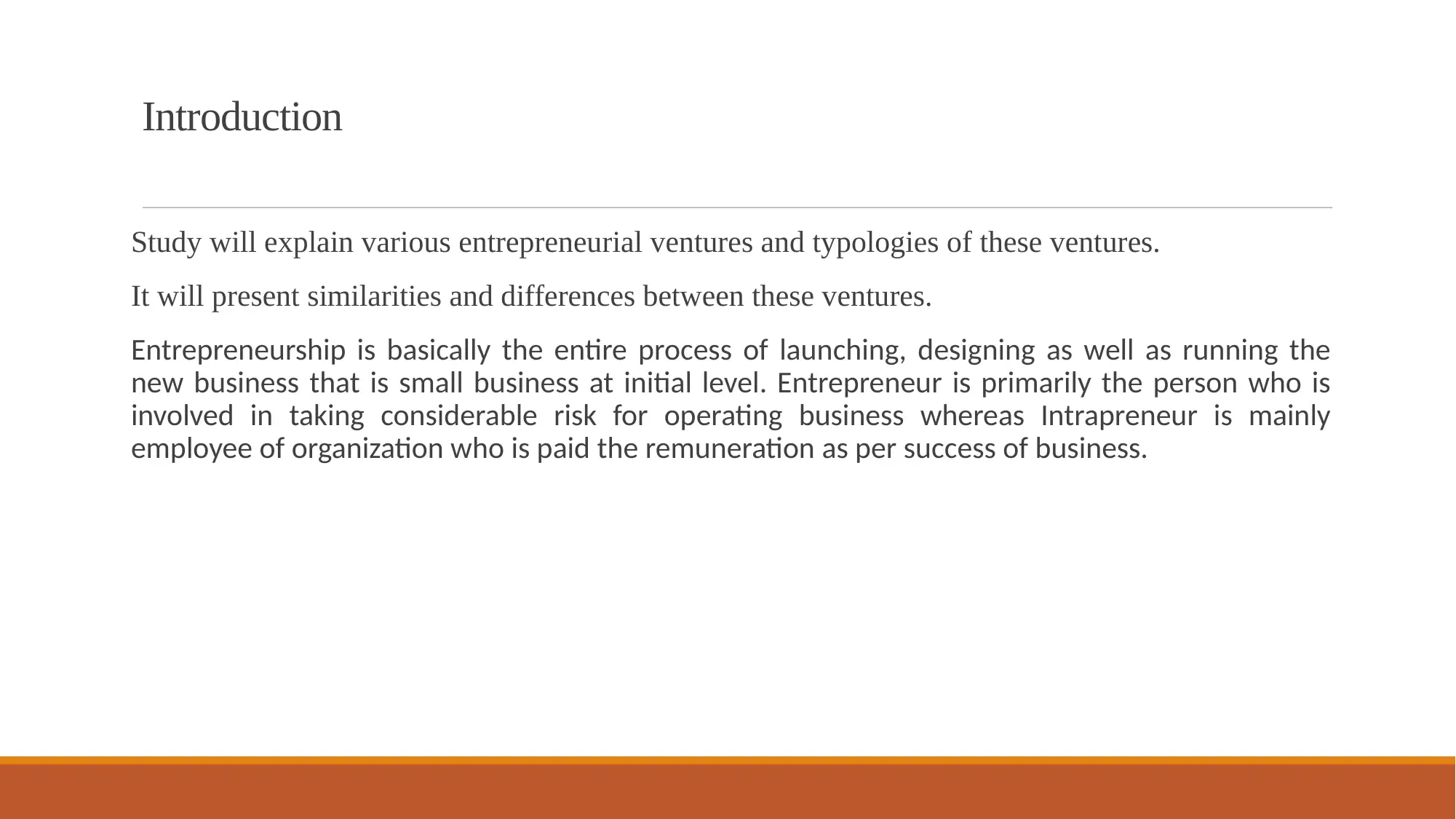
Introduction
Study will explain various entrepreneurial ventures and typologies of these ventures.
It will present similarities and differences between these ventures.
Entrepreneurship is basically the entire process of launching, designing as well as running the
new business that is small business at initial level. Entrepreneur is primarily the person who is
involved in taking considerable risk for operating business whereas Intrapreneur is mainly
employee of organization who is paid the remuneration as per success of business.
Study will explain various entrepreneurial ventures and typologies of these ventures.
It will present similarities and differences between these ventures.
Entrepreneurship is basically the entire process of launching, designing as well as running the
new business that is small business at initial level. Entrepreneur is primarily the person who is
involved in taking considerable risk for operating business whereas Intrapreneur is mainly
employee of organization who is paid the remuneration as per success of business.
⊘ This is a preview!⊘
Do you want full access?
Subscribe today to unlock all pages.

Trusted by 1+ million students worldwide
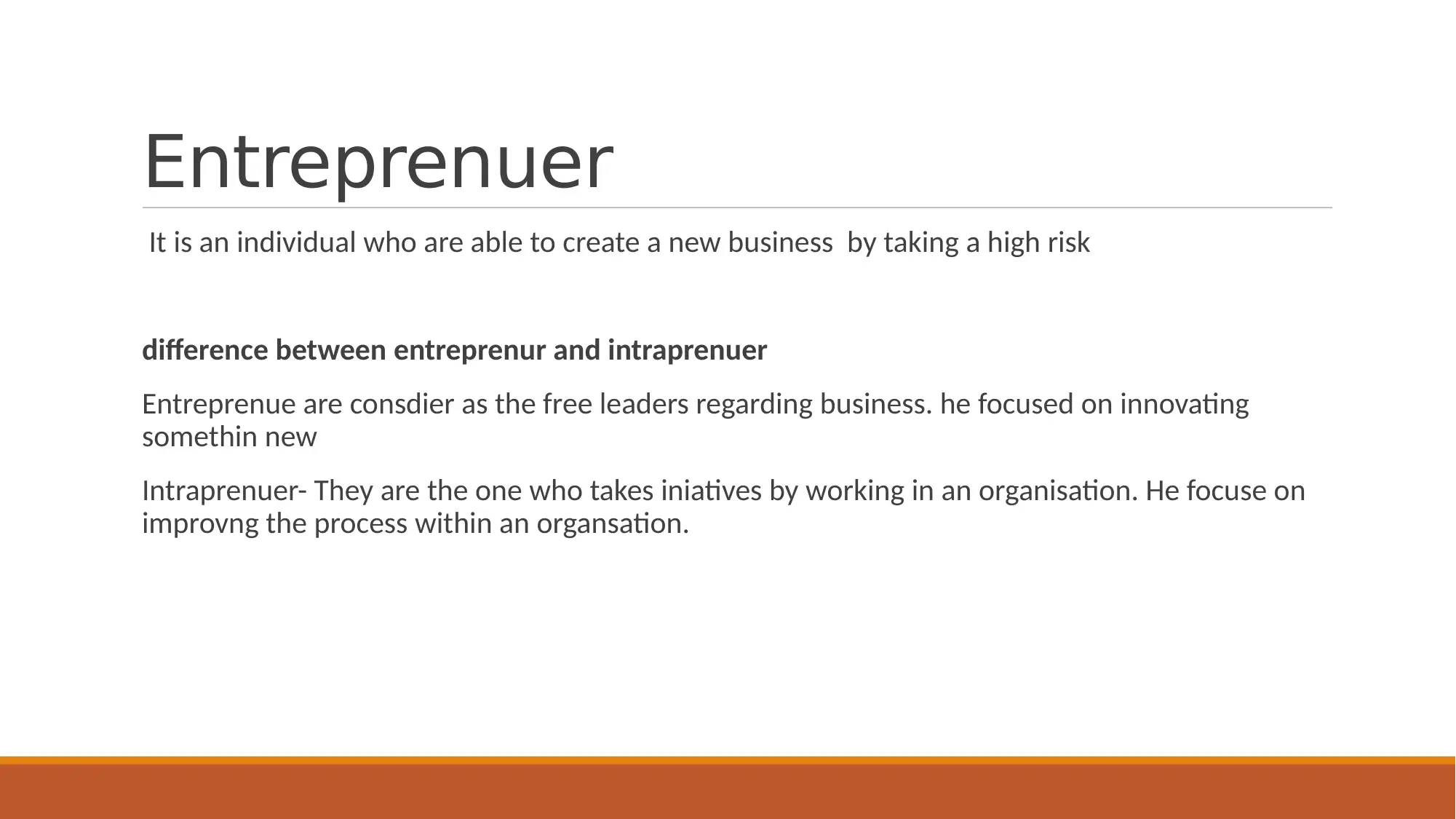
Entreprenuer
It is an individual who are able to create a new business by taking a high risk
difference between entreprenur and intraprenuer
Entreprenue are consdier as the free leaders regarding business. he focused on innovating
somethin new
Intraprenuer- They are the one who takes iniatives by working in an organisation. He focuse on
improvng the process within an organsation.
It is an individual who are able to create a new business by taking a high risk
difference between entreprenur and intraprenuer
Entreprenue are consdier as the free leaders regarding business. he focused on innovating
somethin new
Intraprenuer- They are the one who takes iniatives by working in an organisation. He focuse on
improvng the process within an organsation.
Paraphrase This Document
Need a fresh take? Get an instant paraphrase of this document with our AI Paraphraser
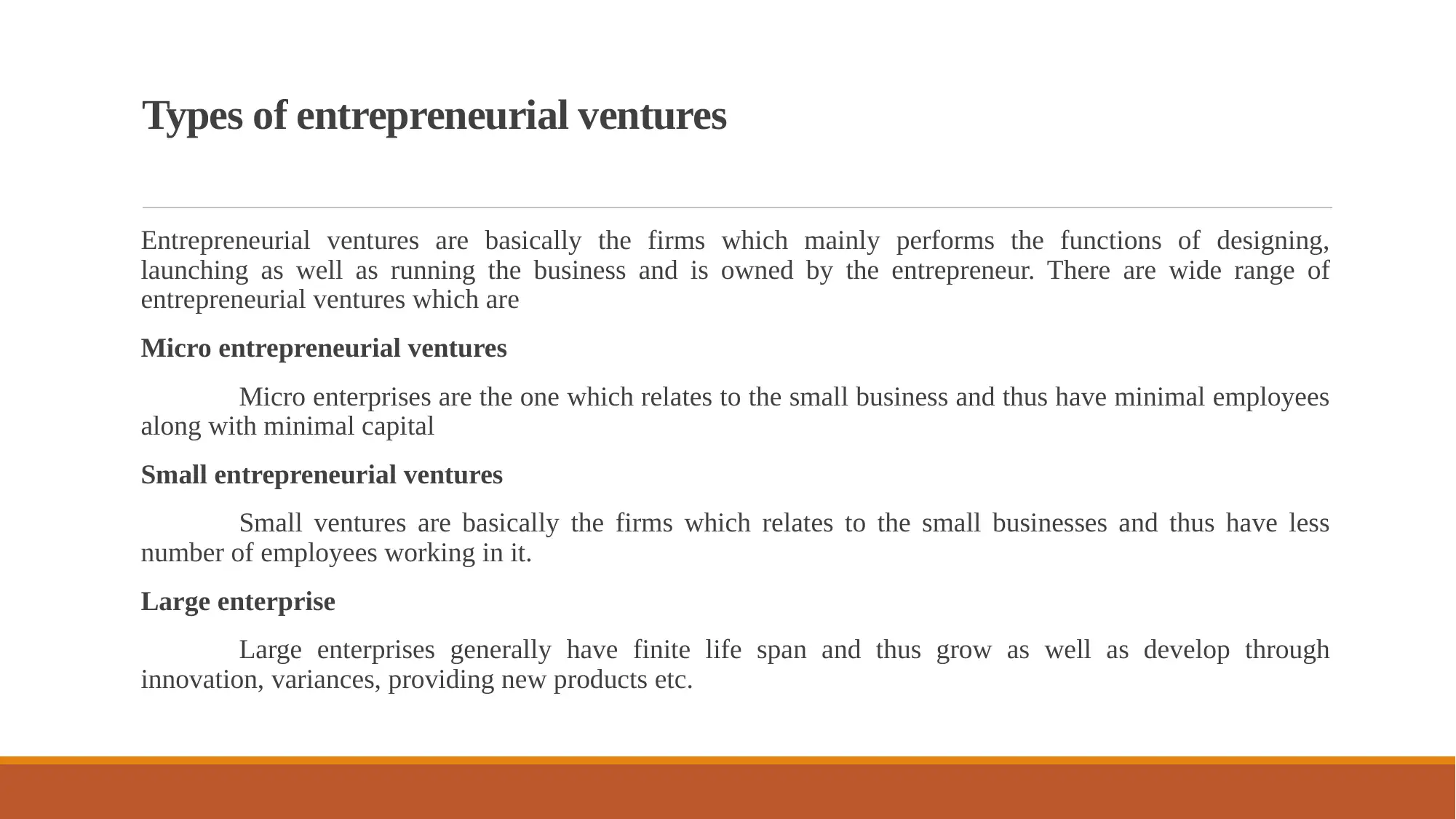
Types of entrepreneurial ventures
Entrepreneurial ventures are basically the firms which mainly performs the functions of designing,
launching as well as running the business and is owned by the entrepreneur. There are wide range of
entrepreneurial ventures which are
Micro entrepreneurial ventures
Micro enterprises are the one which relates to the small business and thus have minimal employees
along with minimal capital
Small entrepreneurial ventures
Small ventures are basically the firms which relates to the small businesses and thus have less
number of employees working in it.
Large enterprise
Large enterprises generally have finite life span and thus grow as well as develop through
innovation, variances, providing new products etc.
Entrepreneurial ventures are basically the firms which mainly performs the functions of designing,
launching as well as running the business and is owned by the entrepreneur. There are wide range of
entrepreneurial ventures which are
Micro entrepreneurial ventures
Micro enterprises are the one which relates to the small business and thus have minimal employees
along with minimal capital
Small entrepreneurial ventures
Small ventures are basically the firms which relates to the small businesses and thus have less
number of employees working in it.
Large enterprise
Large enterprises generally have finite life span and thus grow as well as develop through
innovation, variances, providing new products etc.
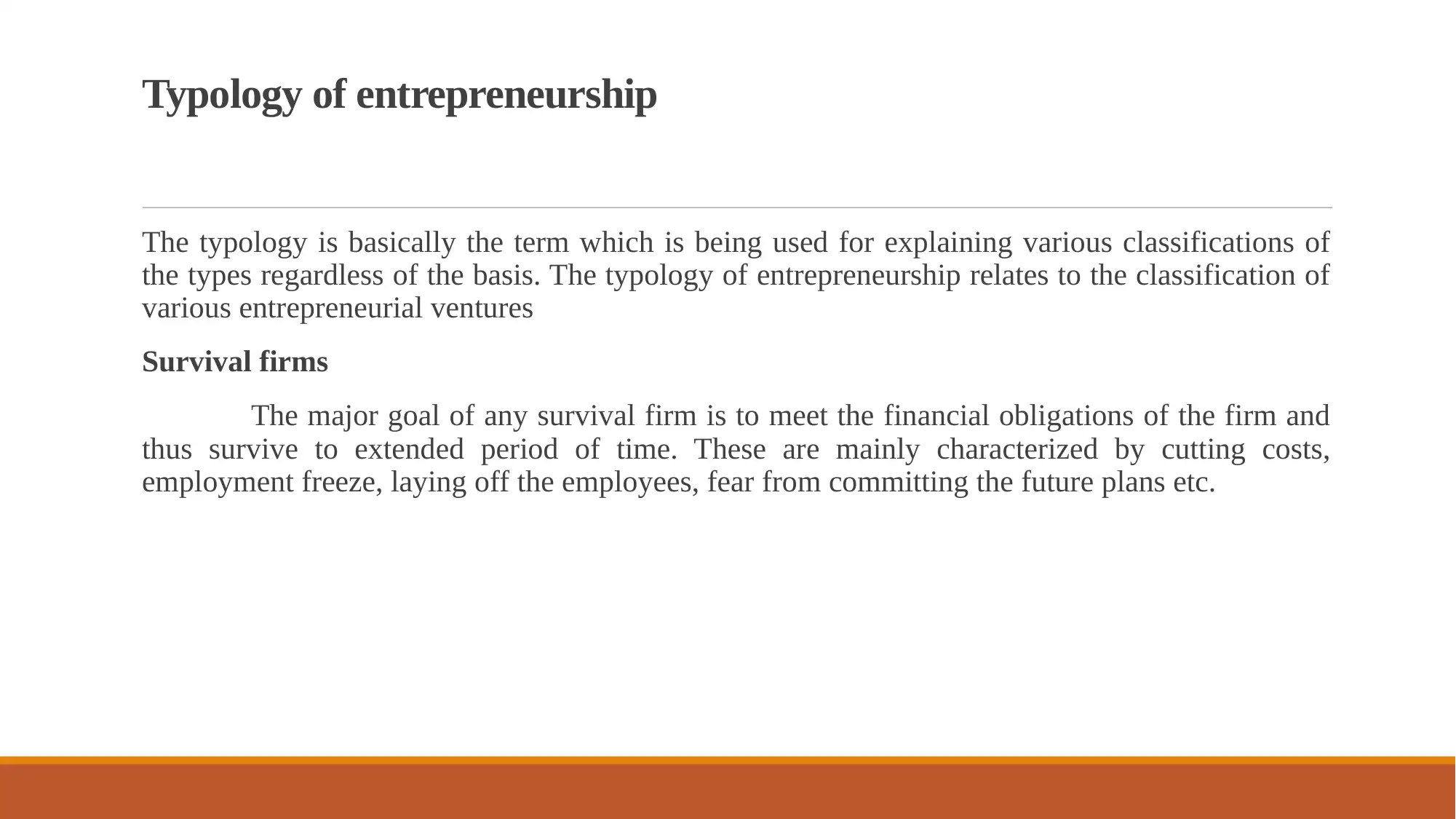
Typology of entrepreneurship
The typology is basically the term which is being used for explaining various classifications of
the types regardless of the basis. The typology of entrepreneurship relates to the classification of
various entrepreneurial ventures
Survival firms
The major goal of any survival firm is to meet the financial obligations of the firm and
thus survive to extended period of time. These are mainly characterized by cutting costs,
employment freeze, laying off the employees, fear from committing the future plans etc.
The typology is basically the term which is being used for explaining various classifications of
the types regardless of the basis. The typology of entrepreneurship relates to the classification of
various entrepreneurial ventures
Survival firms
The major goal of any survival firm is to meet the financial obligations of the firm and
thus survive to extended period of time. These are mainly characterized by cutting costs,
employment freeze, laying off the employees, fear from committing the future plans etc.
⊘ This is a preview!⊘
Do you want full access?
Subscribe today to unlock all pages.

Trusted by 1+ million students worldwide

Cont..
Lifestyle entrepreneurship
The major objective of these
entrepreneurship is to undertake the
activities which owner enjoys as well as to
provide the reasonable living to founders
instead of incurring the risks.
The small business and enterprises mainly
provides the avenue for developing
particular entrepreneurial cultures like
lifestyle entrepreneur.
Lifestyle entrepreneurship
The major objective of these
entrepreneurship is to undertake the
activities which owner enjoys as well as to
provide the reasonable living to founders
instead of incurring the risks.
The small business and enterprises mainly
provides the avenue for developing
particular entrepreneurial cultures like
lifestyle entrepreneur.
Paraphrase This Document
Need a fresh take? Get an instant paraphrase of this document with our AI Paraphraser
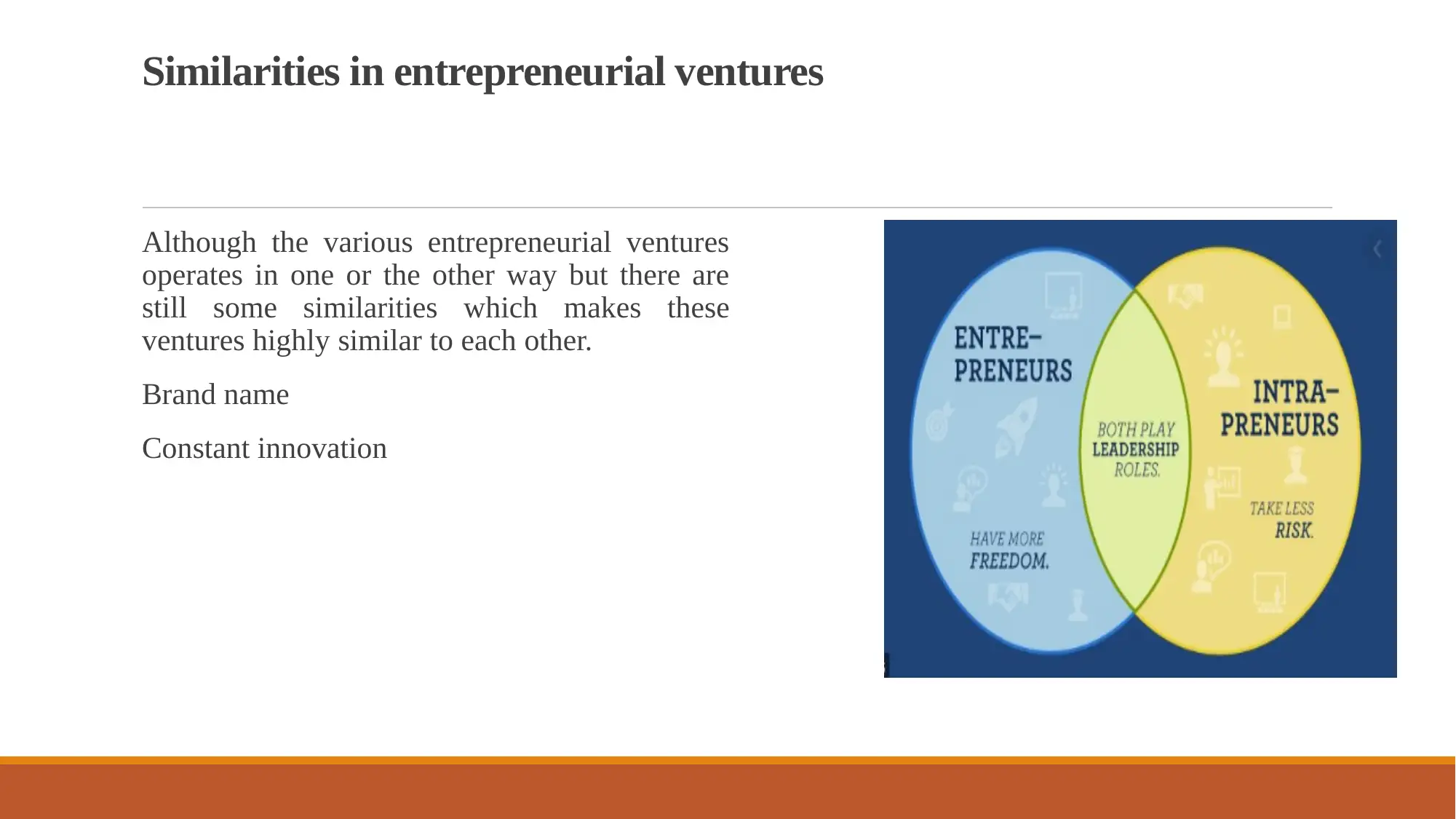
Similarities in entrepreneurial ventures
Although the various entrepreneurial ventures
operates in one or the other way but there are
still some similarities which makes these
ventures highly similar to each other.
Brand name
Constant innovation
Although the various entrepreneurial ventures
operates in one or the other way but there are
still some similarities which makes these
ventures highly similar to each other.
Brand name
Constant innovation
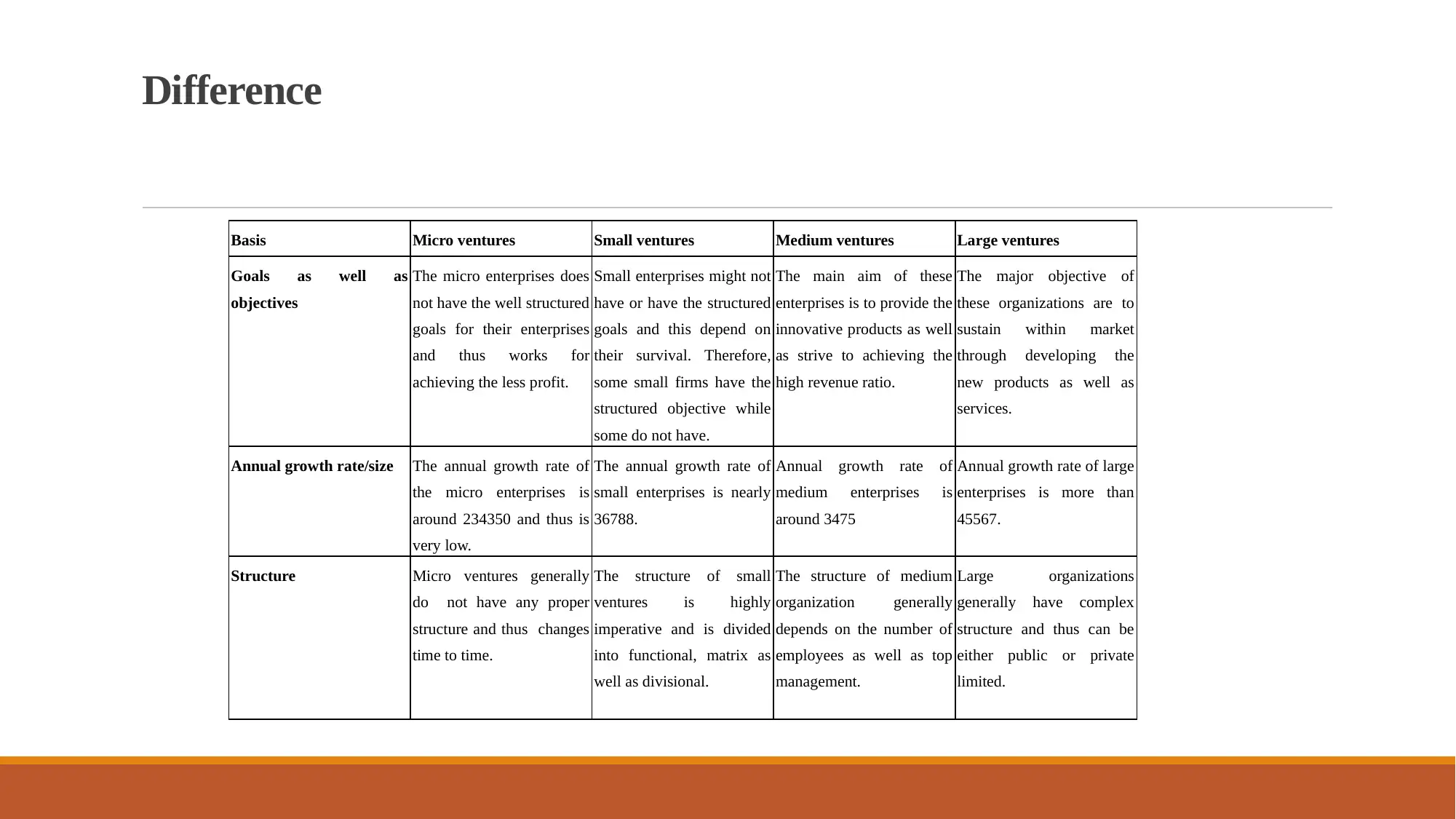
Difference
Basis Micro ventures Small ventures Medium ventures Large ventures
Goals as well as
objectives
The micro enterprises does
not have the well structured
goals for their enterprises
and thus works for
achieving the less profit.
Small enterprises might not
have or have the structured
goals and this depend on
their survival. Therefore,
some small firms have the
structured objective while
some do not have.
The main aim of these
enterprises is to provide the
innovative products as well
as strive to achieving the
high revenue ratio.
The major objective of
these organizations are to
sustain within market
through developing the
new products as well as
services.
Annual growth rate/size The annual growth rate of
the micro enterprises is
around 234350 and thus is
very low.
The annual growth rate of
small enterprises is nearly
36788.
Annual growth rate of
medium enterprises is
around 3475
Annual growth rate of large
enterprises is more than
45567.
Structure Micro ventures generally
do not have any proper
structure and thus changes
time to time.
The structure of small
ventures is highly
imperative and is divided
into functional, matrix as
well as divisional.
The structure of medium
organization generally
depends on the number of
employees as well as top
management.
Large organizations
generally have complex
structure and thus can be
either public or private
limited.
Basis Micro ventures Small ventures Medium ventures Large ventures
Goals as well as
objectives
The micro enterprises does
not have the well structured
goals for their enterprises
and thus works for
achieving the less profit.
Small enterprises might not
have or have the structured
goals and this depend on
their survival. Therefore,
some small firms have the
structured objective while
some do not have.
The main aim of these
enterprises is to provide the
innovative products as well
as strive to achieving the
high revenue ratio.
The major objective of
these organizations are to
sustain within market
through developing the
new products as well as
services.
Annual growth rate/size The annual growth rate of
the micro enterprises is
around 234350 and thus is
very low.
The annual growth rate of
small enterprises is nearly
36788.
Annual growth rate of
medium enterprises is
around 3475
Annual growth rate of large
enterprises is more than
45567.
Structure Micro ventures generally
do not have any proper
structure and thus changes
time to time.
The structure of small
ventures is highly
imperative and is divided
into functional, matrix as
well as divisional.
The structure of medium
organization generally
depends on the number of
employees as well as top
management.
Large organizations
generally have complex
structure and thus can be
either public or private
limited.
⊘ This is a preview!⊘
Do you want full access?
Subscribe today to unlock all pages.

Trusted by 1+ million students worldwide

Cont…
Basis Public Private social
Objectives The main objective of public
enterprises to maximize profits for
increasing shareholder value.
The main objective of private
enterprises is to innovate their
products as well as services to high
extent and generate revenue.
These organizations mainly aim for
providing quality products as well
as services to entire community
Size The number of employees in public
companies are generally more than
8000.
Number of employees in public
organizations are more than
100000
The employees which are present
in social organizations generally
depends its size.
Structure The organizational structure of
public companies are highly
complex and thus consists of large
hierarchical levels.
Structure of private companies
mainly depends upon the size as
well as number of employees.
The structure of the social
enterprises are mainly based upon
the trustees as well as board of
directors.
Basis Public Private social
Objectives The main objective of public
enterprises to maximize profits for
increasing shareholder value.
The main objective of private
enterprises is to innovate their
products as well as services to high
extent and generate revenue.
These organizations mainly aim for
providing quality products as well
as services to entire community
Size The number of employees in public
companies are generally more than
8000.
Number of employees in public
organizations are more than
100000
The employees which are present
in social organizations generally
depends its size.
Structure The organizational structure of
public companies are highly
complex and thus consists of large
hierarchical levels.
Structure of private companies
mainly depends upon the size as
well as number of employees.
The structure of the social
enterprises are mainly based upon
the trustees as well as board of
directors.
Paraphrase This Document
Need a fresh take? Get an instant paraphrase of this document with our AI Paraphraser
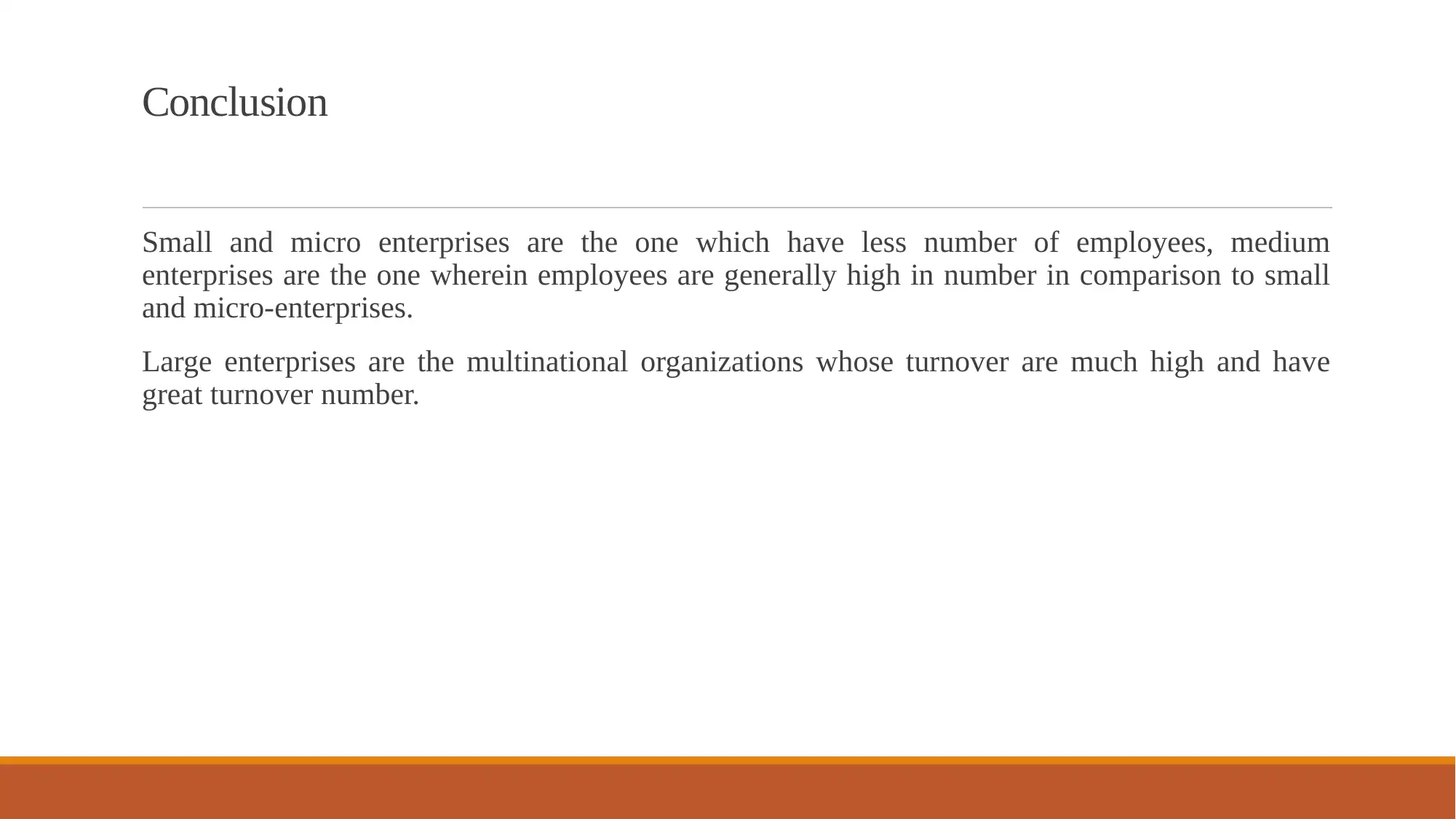
Conclusion
Small and micro enterprises are the one which have less number of employees, medium
enterprises are the one wherein employees are generally high in number in comparison to small
and micro-enterprises.
Large enterprises are the multinational organizations whose turnover are much high and have
great turnover number.
Small and micro enterprises are the one which have less number of employees, medium
enterprises are the one wherein employees are generally high in number in comparison to small
and micro-enterprises.
Large enterprises are the multinational organizations whose turnover are much high and have
great turnover number.

REFERENCES
DeSantola, A. and Gulati, R., 2017. Scaling: Organizing and growth in entrepreneurial ventures.
Academy of Management Annals.11(2). pp.640-668.
Kuratko, D.F., 2016. Different entrepreneurial ventures for greater societal value: A portfolio
approach to assist public policy. The Antitrust Bulletin. 61(4). pp.546-560.
DeSantola, A. and Gulati, R., 2017. Scaling: Organizing and growth in entrepreneurial ventures.
Academy of Management Annals.11(2). pp.640-668.
Kuratko, D.F., 2016. Different entrepreneurial ventures for greater societal value: A portfolio
approach to assist public policy. The Antitrust Bulletin. 61(4). pp.546-560.
⊘ This is a preview!⊘
Do you want full access?
Subscribe today to unlock all pages.

Trusted by 1+ million students worldwide
1 out of 13
Related Documents
Your All-in-One AI-Powered Toolkit for Academic Success.
+13062052269
info@desklib.com
Available 24*7 on WhatsApp / Email
![[object Object]](/_next/static/media/star-bottom.7253800d.svg)
Unlock your academic potential
Copyright © 2020–2025 A2Z Services. All Rights Reserved. Developed and managed by ZUCOL.





